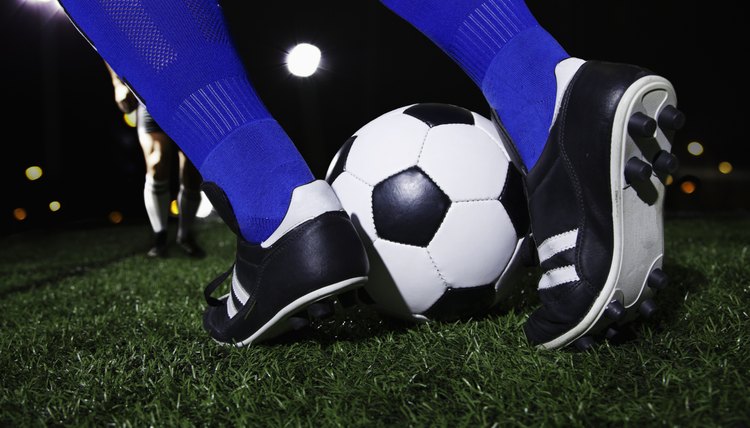The Difference Between Soccer & Rugby Cleats

At first glance, rugby and soccer cleats may look the same, yet they have some characteristic differences. Rugby players hold the ball, while soccer players maneuver the ball with their feet. Key features make each type of cleat more appropriate for rugby or soccer. If you're tempted to use the same cleats for both sports, note that some rules and regulations may prevent such a crossover.
Support and Construction
Rugby cleats vary depending on the position of the player. Forwards usually wear higher topped rugby cleats that resemble boots to protect the ankles from oncoming rucks and mauls. Rugby shoes are generally heavier than soccer cleats. Soccer cleats are made to be extremely light to allow players speed and accuracy while kicking the ball. Leg protection in soccer is provided by shin pads and socks, so soccer cleats have low tops and less ankle support.
Material
The first rugby boots were made of genuine leather, which posed a problem in wet conditions. Boots had to be removed, dried overnight and stuffed with newspaper to hold their shape, according to Rugby Football History. Today, rugby boots are often made from kangaroo leather -- they are easier to care for and lighter on your feet. Soccer cleats were originally constructed much like rugby cleats. Modern soccer cleats are made of synthetic materials -- these are lighter on your feet and better for muddy fields. Some players may choose to wear leather soccer cleats for dry conditions.
Cleats
The number of cleats on the bottom is one of the biggest differences between soccer and rugby cleats. Regulation rugby cleats have 10 spikes on the bottom and soccer cleats usually have 16. Both rugby and soccer shoes feature removable screw cleats so you can adjust your shoes to any playing surface. Choose flatter cleats for shorter grass and soft ground, and longer cleats for longer grass and hard ground.
Crossing Over
If you play soccer and rugby, you may wonder if you can purchase just one pair of shoes for both. Choose a rugby shoe if you cross over -- soccer shoes often have wedge cleats, which aren't allowed in rugby. Synthetic soccer shoes may not offer you enough support and protection for a rough contact sport like rugby. High-top rugby boots may be difficult to wear with shin pads, but you can wear a lower cut rugby cleat to play soccer.
References
Writer Bio
Kay Ireland specializes in health, fitness and lifestyle topics. She is a support worker in the neonatal intensive care and antepartum units of her local hospital and recently became a certified group fitness instructor.
